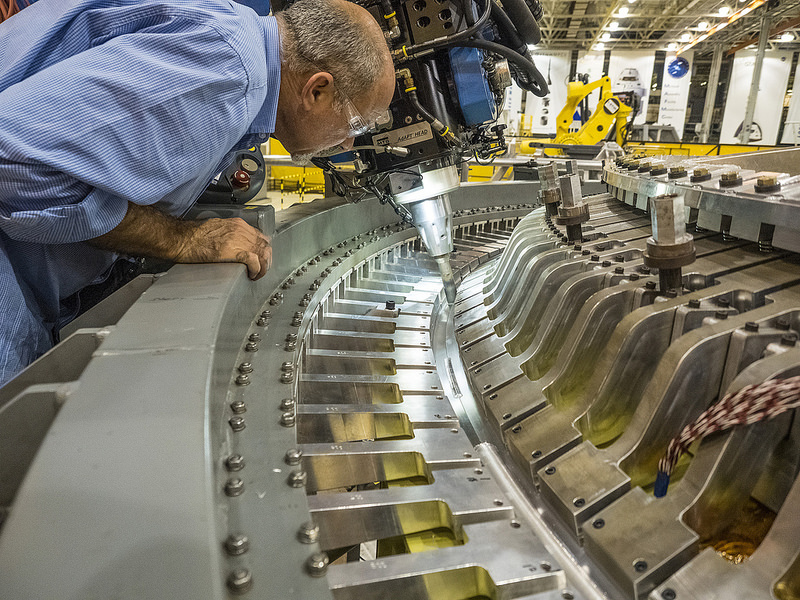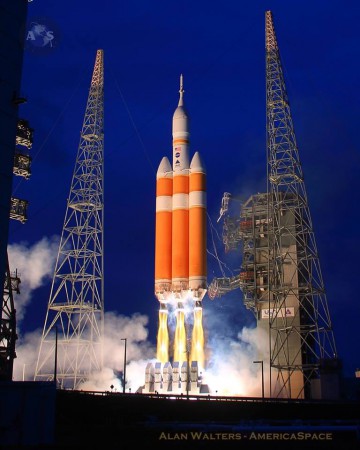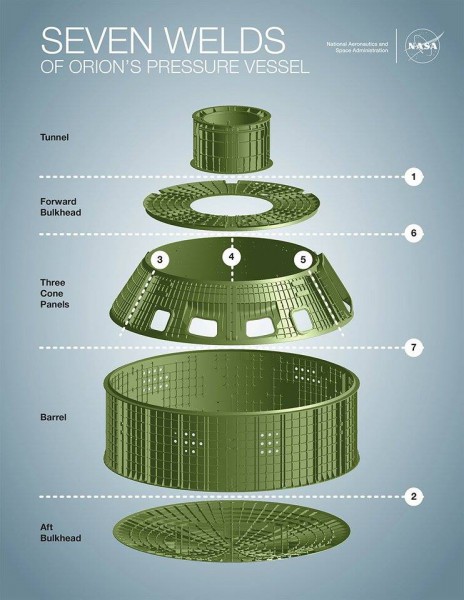
Just six weeks shy of the one-year anniversary of the triumphant maiden voyage of the Orion Multi-Purpose Crew Vehicle (MPCV)—which saw Exploration Flight Test (EFT)-1 achieve a peak apogee of 3,609 miles (5,808 km), some 15 times higher than the orbit of the International Space Station (ISS) and further than any human-capable machine since the Apollo 17 lunar landing mission—Lockheed Martin and NASA today announced that many key design parameters are now sufficiently mature to move the spacecraft into full-scale fabrication, assembly, integration and testing. With the bulk of Orion’s multi-month-long Critical Design Review (CDR) now complete, as well as significant parallel advancements in the Space Launch System (SLS) program in 2015, both vehicle and booster are steadily zeroing-in on the long-awaited Exploration Mission (EM)-1. Slated to occur no sooner than November 2018, the EM-1 voyage will mark the first flight of the SLS and the first flight of a human-capable spacecraft to a Beyond Low-Earth Orbit (BLEO) destination, since the curtain fell on Project Apollo’s lunar dream.
As outlined in AmericaSpace’s series of Orion history articles, published last year, the program to develop a new piloted spacecraft to deliver Americans to BLEO destinations has undergone a tortured development process, ever since its conception—during the first administration of President George W. Bush—back in January 2004. Originally known as the Crew Exploration Vehicle (CEV), it was subsequently renamed “Orion” in August 2006, but both it and its umbrella “Constellation Program” met with stiff political resistance and were terminated in April 2010, early in President Barack Obama’s incumbency of the White House. However, the development of Orion continued and in May 2011 it was “reborn” as the MPCV. Six months later, the EFT-1 mission was baselined as a means of evaluating the spacecraft’s capability to endure the high radiation environment of the Lower Van Allen Belts and survive re-entry velocities in excess of 20,000 mph (32,000 km/h).

Lofted atop a United Launch Alliance (ULA) Delta IV Heavy booster from Cape Canaveral Air Force Station, Fla., on 5 December 2014, EFT-1 was hugely successful and reached the farthest vantage point of a human-capable vehicle since Apollo 17. Following a smooth oceanic splashdown and initial transfer to U.S. Naval Base San Diego, Calif., the spacecraft returned to the Kennedy Space Center (KSC) in Florida, a few days before Christmas, and was shepherded through a protracted period of disassembly and inspection, prior to its future use in the Ascent Abort (AA)-2 test, which is currently targeted to occur from the Cape’s Space Launch Complex (SLC)-46 in 2018.
However, equipped with a single-string navigation system, a structural representation of the cylindrical Service Module (SM) attached to its conical Crew Module (CM), a partial Launch Abort System (LAS) and internal batteries—rather than photovoltaic arrays—EFT-1 did not represent a “full-up” Orion spacecraft and the post-flight inspections allowed for a number of changes to be implemented into the design, ahead of the unpiloted Exploration Mission (EM)-1, no sooner than November 2018. One such change, effected earlier this year, was the decision to implement six “compression pads”, made from an innovative 3-D woven material of quartz fibers, which will be integrated into Orion’s Thermal Protection System (TPS) at the CM/SM interface, in tandem with the spacecraft’s primary Avcoat ablator.
This work was accompanied by extensive core sampling and laser scanning of EFT-1’s heat shield in the opening months of 2015. In March, the 5,000-pound (2,270 kg) heat shield was delivered to NASA’s Marshall Space Flight Center (MSFC) in Huntsville, Ala., where it was milled and Avcoat sample “squares” were removed from its ablated surface for detailed analysis. Then, in early June, the heat shield was delivered to the Langley Research Center (LaRC) in Hampton, Va., for water impact testing in early 2016 in the Hydro Impact Basin. This is expected to result in full water-landing certification for Orion, prior to the AA-2 test of the LAS in 2018. The latter will see the spacecraft, mounted atop a converted Peacekeeper missile and outfitted with a fully functional LAS, whose trio of solid-fueled motors—abort motor, attitude-control motor and jettison motor—will demonstrate the capability to pull Orion away from a failed launch vehicle in flight.

Each of these incremental steps positioned the Orion Program confidently at Key Decision Point (KDP)-C, described as “the first time NASA has reached this level of progress for a spacecraft designed to take humans into deep space beyond the Moon, including to an asteroid placed in lunar orbit and on the journey to Mars”. It was stressed that performance data from EFT-1 had assisted with the improvement of manufacturing processes, as the first pair of welds for EM-1 CM were made at the Michoud Assembly Facility (MAF) in New Orleans, La. Additionally, earlier this month, Aerojet completed a major subsystems review of its Reaction Control System (RCS) and jettison motor hardware for the EM-1 mission.
And in August, the program entered its multi-month-long Critical Design Review (CDR) phase, described as “a rallying point for those with technical stakes in building and flying future Orion missions to ensure all elements are in sync, before moving ahead with full-scale fabrication, assembly, integration and testing.” In addition to its focus upon the EM-1 spacecraft’s design, the review analyzed “additional common elements”—including the structure, pyrotechnics, LAS, software and Guidance, Navigation & Control (GNC)—which will be aboard EM-2, the first piloted Orion mission, presently scheduled to occur no later than April 2023. According to today’s Lockheed Martin announcement, the majority of the CDR is now complete, which means that the design of the spacecraft is sufficiently mature to move into full-scale fabrication, assembly, integration and testing, prior to the EM-1 mission. The EM-1 CDR process is expected to conclude after the European Space Agency (ESA)-built Service Module completes its own CDR and presents to the NASA Agency Program Management Council, early next spring.
“The vast majority of Orion’s design is over, and now we will only change things when new requirements come into play,” said Michael Hawes, Lockheed Martin’s Orion Vice President and Program Manager. “Considering the incredible complexity of this spacecraft, the team is very proud to have successfully completed the design review and is looking forward to seeing it fly.” Early next year, the EM-1 CM pressure vessel will be shipped to the Operations & Checkout (O&C) facility at KSC for final assembly, integration and testing, preparatory to its flight aboard the first SLS booster. “The test flight will send Orion into lunar distant retrograde orbit, a wide orbit around the Moon that is farther from Earth than any human-rated spacecraft has ever traveled,” Lockheed Martin noted. “The mission will last more than 20 days and will help certify the design and safety of Orion and SLS for human-rated exploration missions.”
Be sure to “Like” AmericaSpace on Facebook and follow us on Twitter: @AmericaSpace
.
Missions » SLS » EFT-1 » Missions » SLS » Missions » SLS » EM-1 »





Good news and a lovely article!
Thank you Ben Evans!
Yes, really good journalism. Good job.
Will the Orion spacecraft have a toilet?
It does have a toilet but I doubt finding that out is why you made the comment.
Tom Servo 6 months ago
“Doesn’t bother me to watch the yard apes burn their own neighborhoods to the ground.”
You might want to make your disqus account private. Otherwise when you make toilet comments someone just might find out what a climate denying, racist, liberal hating wackadoodle you are.
A toilet in space needs to be called “The Proxmire”
Great job meeting all the important milestones for the Orion & SLS. Looking forward to the launch of EM-1 in 2018. Despite all the criticism & hate the SLS gets for being ‘to expensive’ or ‘underfunded’ I see SLS & Orion accomplishing historic missions in the near future. Compared to the Saturn 5 program the SLS will be relatively cheaper & more capable.
The Space Shuttle recived about the same criticism & hate as the SLS is currently receiving but look at all the Shuttle program has accomplished. Now thanks to the U.S. Space Shuttle & international partners we have a fully operational space station which was once thought impossible.